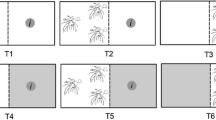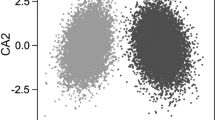Abstract
The invasive crayfish Procambarus clarkii is an omnivore and an ecosystem engineer whose feeding mechanism has reduced the abundance of many native invertebrates and macrophytes. Since macrophytes provide refuges for aquatic insects, macrophyte depletion by crayfish might have indirect negative effects on animal prey in aquatic habitats. We postulated that the prey refuges provided by macrophytes and macrophyte tolerance to crayfish cutting and feeding vary among macrophyte species. We conducted two experiments to (1) investigate differences in macrophyte refuge function for dragonfly larvae against crayfish, and (2) test the tolerance to crayfish cutting and feeding among macrophyte species. Elodea nuttallii (submerged plant), Potamogeton crispus (submerged plant), and Carex idzuroei (emergent plant) had greater refuge effects than Trapa japonica (floating-leaved plant), an effect that might result from the larger total cover of E. nuttallii, P. crispus, and C. idzuroei, and the hardness of C. idzuroei leaves. Tolerance to crayfish cutting and feeding was greater in C. idzuroei than in the other species. As the macro-invertebrate assemblages in submerged vegetation are more abundant and species-rich than those in emergent and floating-leaf vegetation, conservation of E. nuttallii and P. crispus should be prioritized for restoring native aquatic animals in ecosystems invaded by the introduced crayfish.




Similar content being viewed by others
References
Axelsson E, Nyström P, Sidenmark J, Brönmark C (1997) Crayfish predation on amphibian eggs and larvae. Amphib Reptil 18:217–228
Bartholomew A (2002) Total cover and cover quality: predicted and actual effects on a predator’s foraging success. Mar Ecol Prog Ser 227:1–9
Bartholomew A, Diaz RJ, Cicchetti G (2000) New dimensionless indices of structural habitat complexity: predicted and actual effects on a predator’s foraging success. Mar Ecol Prog Ser 206:45–58
Bickel TO, Closs GP (2008) Fish distribution and diet in relation to the invasive macrophyte Lagarosiphon major in the littoral zone of Lake Dunstan, New Zealand. Ecol Freshw Fish 17:10–19
Bolker BM, Brooks ME, Clark CJ, Geange SW, Poulsen JR, Stevens M, Henry H, White JS (2009) Generalized linear mixed models: a practical guide for ecology and evolution. Trends Ecol Evol 3:127–135
Cattaneo A, Galanti G, Gentinetta S, Susana A (1998) Epiphytic algae and macroinvertebrates on submerged and floating-leaved macrophytes in an Italian lake. Freshw Biol 39:725–740
Cobo F, Vieira-Lanero R, Rego E, Servia M (2010) Temporal trends in non-indigenous freshwater species records during the 20th century: a case study in the Iberian Peninsula. Biodivers Conserv 19:3471–3487
Cremona F, Planas D, Lucotte M (2008) Biomass and composition of macroinvertebrate communities associated with different types of macrophyte architectures and habitats in a large fluvial lake. Fundam Appl Limnol 171:119–130
Cronin G (1998) Influence of macrophyte structure, nutritive value and chemistry on the feeding choices of a generalist crayfish. In: Jeppesen E, Sondergaard M, Sondergaard M, Christoffersen K (eds) The structuring role of submerged macrophytes in lakes. Springer, New York, pp 307–317
Cronin G, Lodge DM, Hay ME, Miller M, Hill AM, Horvath T, Bolser RC, Lindquist N, Wahl M (2002) Crayfish feeding preferences for fresh water macrophytes: the influence of plant structure and chemistry. J Crustac Biol 22:708–718
Dionne M, Folt CL (1991) An experimental-analysis of macrophyte growth forms as fish foraging habitat. Can J Fish Aquat Sci 48:123–131
Dorn NJ, Mittelbach GG (1999) More than predator and prey: A review of interactions between fish and crayfish. Vie Et Milieu Life Environ 49:229–237
Doyle RD, Smart RM, Guest C, Bickel K (1997) Establishment of native aquatic plants for fish habitat: test plantings in two north Texas reservoirs. Lake Reserv Manag 13:259–269
Geiger W, Alcorlo P, Baltanas A, Montes C (2005) Impact of an introduced Crustacean on the trophic webs of Mediterranean wetlands. Biol Invasions 7:49–73
Gherardi F (2006) Crayfish invading Europe: the case study of Procambarus clarkii. Mar Freshw Behav Physiol 39:175–191
Gherardi F, Acquistapace P (2007) Invasive crayfish in Europe: the impact of Procambarus clarkii on the littoral community of a Mediterranean lake. Freshw Biol 52:1249–1259
Gherardi F, Renai B, Corti C (2001) Crayfish predation on tadpoles: a comparison between a native (Austropotamobius pallipes) and an alien species (Procambarus clarkii). Bull Fr Pêche Piscic 361:659–668
Hacker SD, Steneck RS (1990) Habitat architecture and the abundance and body-size-dependent habitat selection of a phytal amphipod. Ecology 71:2269–2285
Hamasaki K, Sugizaki M, Sugimoto A, Murakami Y, Kitada S (2011) Emigration behaviour during sea-to-land transition of the coconut crab Birgus latro: effects of gastropod shells, substrata, shelters and humidity. J Exp Mar Biol Ecol 403:81–89
Heck KLJ, Crowder LB (1991) Habitat structure and predator–prey interactions in vegetated aquatic systems. In: Bell SS, Mccoy ED, Mushinsky HR (eds) Habitat complexity: the physical arrangement of objects in space. Chapman and Hall, New York, pp 281–299
Hein CL, Vander Zanden MJ, Magnuson JJ (2007) Intensive trapping and increased fish predation cause massive population decline of an invasive crayfish. Freshw Biol 52:1134–1146
Jeppesen E, Lauridesen TL, Kairesalo T, Perrow MR (1998) Impact of submerged macrophytes on fish–zooplankton interactions in lakes. In: Jeppesen E, Sondergaard M, Sondergaard M, Christoffersen K (eds) The structuring role of submerged macrophytes in lakes. Springer, New York, pp 91–114
Kadono Y (1990) Aquatic macrophytes of the Kako River, Hyogo Prefecture, southwestern Japan (in Japanese with English abstract). Jpn J Ecol 40:151–160
Kadono Y (2007) Change in macrophytic flora of Lake Takkobu, Kushiro, Japan, in past 30 years (in Japanese with English abstract). Jpn J Limnol 68:105–108
Kerby JL, Riley SPD, Kats LB, Wilson P (2005) Barriers and flow as limiting factors in the spread of an invasive crayfish (Procambarus clarkii) in southern California streams. Biol Conserv 126:402–409
Kobayashi R, Maezono Y, Miyashita T (2011) The importance of allochthonous litter input on the biomass of an alien crayfish in farm ponds. Popul Ecol 53:525–534
Kovalenko KE, Dibble ED, Slade JG (2010) Community effects of invasive macrophyte control: role of invasive plant abundance and habitat complexity. J Appl Ecol 47:318–328
Kurihara T, Obata K (2007) The vascular plant flora of Ami Town, Ibaraki Prefecture (the second report) (in Japanese with English abstract). Bull Ibaraki Nat Mus 10:65–100
Lodge DM (1991) Herbivory on freshwater macrophytes. Aquat Bot 41:195–224
Lodge DM, Stein RA, Brown KM, Covich AP, Bronmark C, Garvey JE, Klosiewski SP (1998) Predicting impact of freshwater exotic species on native biodiversity: challenges in spatial scaling. Aust J Ecol 23:53–67
Maezono Y, Miyashita T (2003) Community-level impacts induced by introduced largemouth bass and bluegill in farm ponds in Japan. Biol Conserv 109:111–121
Maezono Y, Kobayashi R, Kusahara M, Miyashita T (2005) Direct and indirect effects of exotic bass and bluegill on exotic and native organisms in farm ponds. Ecol Appl 15:638–650
Matsumura T, Tanf K, Higashimura T, Ushii M, Kura M, Iwamoto S, Miyake M (2002) Study on the water quality and the biota of rivers—investigation on the Saho, the Noto and the Iwai rivers (in Japanese with English abstract). Bull Nara Univ Educ 51(2):1–16
Matsuzaki S, Usio N, Takamura N, Washitani I (2009) Contrasting impacts of invasive engineers on freshwater ecosystems: an experiment and meta-analysis. Oecologia 158:673–686
Meakin CA, Qin JG, Mair GC (2008) Feeding behaviour, efficiency and food preference in yabbies Cherax destructor. Hydrobiologia 605:29–35
Miyake M, Miyashita T (2011) Identification of alien predators that should not be removed for controlling invasive crayfish threatening endangered odonates. Aquat Conserv Mar Freshw Ecosyst 21:292–298
Nagasaka M (2004) Changes in biomass and spatial distribution of Elodea nuttallii (Planch.) St. John, an invasive submerged plant, in oligomesotrophic Lake Kizaki from 1999 to 2002. Limnology 5:129–139
Parker JD, Burkepile DE, Collins DO, Kubanek J, Hay ME (2007) Stream mosses as chemically-defended refugia for freshwater macroinvertebrates. Oikos 116:302–312
Quinn GP, Keough MJ (2002) Experimental design and data analysis for biologist. Cambridge University Press, Cambridge
Renai B, Gherardi F (2004) Predatory efficiency of crayfish: comparison between indigenous and non-indigenous species. Biol Invasions 6:89–99
Rodriguez CF, Becares E, Fernandez-Alaez M, Fernandez-Alaez C (2005) Loss of diversity and degradation of wetlands as a result of introducing exotic crayfish. Biol Invasions 7:75–85
R Development Core Team (2011) R: a language and environment for statistical computing. R Foundation for Statistical Computing, Vienna, Austria (http://www.R-project.org)
Sala OE, Chapin FS, Armesto JJ, Berlow E, Bloomfield J, Dirzo R, Huber-Sanwald E, Huenneke LF, Jackson RB, Kinzig A, Leemans R, Lodge DM, Mooney HA, Oesterheld M, Poff NL, Sykes MT, Walker BH, Walker M, Wall DH (2000) Global biodiversity scenarios for the year 2100. Science 287:1770–1774
Schuetz JG (2005) Reduced growth but not survival of chicks with altered gape patterns: implications for the evolution of nestling similarity in a parasitic finch. Anim Behav 70:839–848
Sloey D, Schenck T, Narf R (1997) Distribution of aquatic invertebrates within a dense bed of Eurasian milfoil (Myriophyllum spicatum L). J Freshw Ecol 12:303–313
Smart RM, Dick GO, Doyle RD (1998) Techniques for establishing native aquatic plants. J Aquat Plant Manag 36:44–49
Smart AC, Harper DM, Malaisse F, Schmitz S, Coley S, de Beauregard ACG (2002) Feeding of the exotic Louisiana red swamp crayfish, Procambarus clarkii (Crustacea, Decapoda), in an African tropical lake: Lake Naivasha, Kenya. Hydrobiologia 488:129–142
Strayer DL (2010) Alien species in fresh waters: ecological effects, interactions with other stressors, and prospects for the future. Freshw Biol 55:152–174
Tessier C, Cattaneo A, Pinell-Alloul B, Galanti G, Morabito G (2004) Biomass, composition and size structure of invertebrate communities associated to different types of aquatic vegetation during summer in Lago di Candia (Italy). J Limnol 63:190–198
Ueyama A, Shibuta M, Mizukami S, Watanabe M, Nishimoto F, Suda H, Ishida N (2005) Observations in a small river reach for comprehension and conservation of environment—study on the habitats of benthic animal community (especially for larvae of odonate species) in Noda river, a reach of the Toyogawa river (in Japanese with English abstract). J Nagoya Women’s Univ 51:137–145
Urabe K, Ikemoto T, Takei S (1990) Studies on Sympetrum frequens (Odonata:Libellulidae) nymphs as natural enemies of the mosquito larvae, Anopheles sinensis, in rice fields : 4 prey–predator relationship in the rice field areas (in Japanese with English abstract). Med Entomol Zool 41:265–272
Usio N, Townsend CR (2002) Functional significance of crayfish in stream food webs: roles of omnivory, substrate heterogeneity and sex. Oikos 98:512–522
Usio N, Kamiyama R, Saji A, Takamura N (2009) Size-dependent impacts of invasive alien crayfish on a littoral marsh community. Biol Conserv 142:1480–1490
Warfe DM, Barmuta LA (2004) Habitat structural complexity mediates the foraging success of multiple predator species. Oecologia 141:171–178
Wilson KA, Magnuson JJ, Lodge DM, Hill AM, Kratz TK, Perry WL, Willis TV (2004) A long-term rusty crayfish (Orconectes rusticus) invasion: dispersal patterns and community change in a north temperate lake. Can J Fish Aquat Sci 61:2255–2266
Acknowledgments
We are grateful to Moe Miyake, Shun Takagi, Hisako Chidani and the members of the Laboratory of Biodiversity Science (The University of Tokyo) for providing useful advice and helpful support of the experimental work. We also thank Naoki Yasumura, Dai Kusumoto for giving us the place to conduct an experiment in Tanashi Forest (The University of Tokyo), and Kazuo Obata, Shigeru Komatsuzaki and Noriko Takamura for the help with collecting macrophytes in Ibaraki Nature Museum and National Institute for Environmental studies. Constructive comments on the manuscript from Jun Nishihiro were appreciated. This study was supported financially in part by the GCOE program (Asian Conservation Ecology) from the Ministry of Education, Culture, Sports, Science and Technology of Japan, by the Sumitomo Foundation (No. 093117) and by Grant-in-Aid for JSPS Fellows (KAKENHI 22-4267) to S. N.
Author information
Authors and Affiliations
Corresponding author
Additional information
Handling Editor: Nisikawa Usio
Rights and permissions
About this article
Cite this article
Sato, M., Nishijima, S. & Miyashita, T. Differences in refuge function for prey and tolerance to crayfish among macrophyte species. Limnology 15, 27–35 (2014). https://doi.org/10.1007/s10201-013-0410-3
Received:
Accepted:
Published:
Issue Date:
DOI: https://doi.org/10.1007/s10201-013-0410-3




